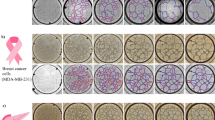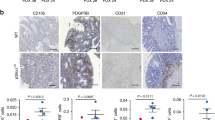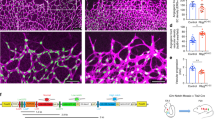Abstract
The growth factor VEGF (vascular endothelial growth factor) promotes the formation of blood vessels in a process known as angiogenesis by inducing the proliferation and migration of endothelial cells1. We show here that VEGF has another proangiogenic function — it can stimulate the elongation, network formation and branching of non-proliferating endothelial cells in culture that are deprived of oxygen and nutrients. As endothelial cells in tumours are exposed to chronic or intermittent hypoxic conditions2,3, we propose that autocrine endothelial VEGF contributes to the formation of blood vessels in a tumour and promotes its survival.
This is a preview of subscription content, access via your institution
Access options
Subscribe to this journal
Receive 51 print issues and online access
$199.00 per year
only $3.90 per issue
Buy this article
- Purchase on Springer Link
- Instant access to full article PDF
Prices may be subject to local taxes which are calculated during checkout


Similar content being viewed by others
References
Carmeliet, P. Nature Med. 6, 389–395 (2000).
Helmlinger, G., Yuan, F., Dellian, M. & Jain, R. K. Nature Med. 3, 177–182 (1997).
Kimura, H. et al. Cancer Res. 56, 5522– 5528 (1996).
Hlatky, L. & Alpen, E. L. Cell Tissue Kinet. 18, 597–611 (1985).
Hlatky, L., Hahnfeldt, P., Tsionou, C. & Coleman, C. N. Br. J. Cancer. 74, S151–S156 (1996).
Hlatky, L. et al. Cancer Res. 54, 6083– 6086 (1994).
Ferrara, N. & Davis-Smyth, T. Endocr. Rev. 18, 4–25 (1997).
Nomura, M. et al. J. Biol. Chem. 270, 28316– 28324 (1995).
Sholley, M. M. et al. Lab Invest. 51, 624– 634 (1984).
Patan, S., Munn, L. & Jain, R. K. Microvasc. Res. 51, 260– 272 (1996).
Namiki, A. et al. J. Biol. Chem. 270, 31189– 31195 (1995).
Liu, Y. et al. J. Biol. Chem. 273, 15257– 15262 (1998).
Torres Filho, I. P. & Intaglietta, M. Am. J. Physiol. 265, H1434–H1438 ( 1993).
Author information
Authors and Affiliations
Supplementary information
Rights and permissions
About this article
Cite this article
Helmlinger, G., Endo, M., Ferrara, N. et al. Formation of endothelial cell networks. Nature 405, 139–141 (2000). https://doi.org/10.1038/35012132
Issue Date:
DOI: https://doi.org/10.1038/35012132
This article is cited by
-
Angiogenic potency evaluation of cell therapy candidates by a novel application of the in vitro aortic ring assay
Stem Cell Research & Therapy (2017)
-
Endothelial cell metabolism and implications for cancer therapy
British Journal of Cancer (2012)
Comments
By submitting a comment you agree to abide by our Terms and Community Guidelines. If you find something abusive or that does not comply with our terms or guidelines please flag it as inappropriate.



